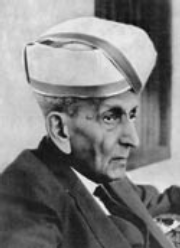
|
||||
|
|
 Sir
Mokshagundam Visvesvaraya, was a notable Indian
engineer, scholar, and statesman born at
Muddenahalli, near Kanivenarayanapura, in
present-day Chikballapur District of Karnataka
State. He was a recipient of the Indian Republic's
highest honour, the Bharat Ratna, in 1955. He was
knighted as a Commander of the Indian Empire by King
George V for his myriad contributions to the public
good. Every year, 15 September is celebrated as
Engineer's Day in India in his memory. He is held in
high regard as the first and pre-eminent engineer of
India. Sir
Mokshagundam Visvesvaraya, was a notable Indian
engineer, scholar, and statesman born at
Muddenahalli, near Kanivenarayanapura, in
present-day Chikballapur District of Karnataka
State. He was a recipient of the Indian Republic's
highest honour, the Bharat Ratna, in 1955. He was
knighted as a Commander of the Indian Empire by King
George V for his myriad contributions to the public
good. Every year, 15 September is celebrated as
Engineer's Day in India in his memory. He is held in
high regard as the first and pre-eminent engineer of
India.Visvesvaraya was born to Srinivasa Shastry and Venkata lakshmamma at Muddenahalli village, Kanivenarayanapura hobli, Chikkaballapur District of present-day Karnataka, in what was then the princely state of Mysore. His mother tongue was Telugu. Srinivasa Sastry was a Sanskrit scholar and an authority on the Hindu scriptures, besides being an Ayurvedic practitioner. His mother was venkata lakshmamma. Visvesvaraya lost his father at the age of 15. He attended primary school at Chikkaballapur and high school at Bangalore.He studied his B.A. at Central College, Bangalore, affiliated to Madras University in 1881 and later studied Civil Engineering at the College of Science, Pune, now known as the College of Engineering, Pune (COEP).
Upon graduating as an engineer, Visvesvaraya took up a job with the Public Works Department (PWD) of Bombay (now known as Mumbai) and was later invited to join the Indian Irrigation Commission. He implemented an extremely intricate system of irrigation in the Deccan area. He also designed and patented a system of automatic weir water floodgates that were first installed in 1903 at the Khadakvasla Reservoir near Pune. These gates were employed to raise the flood supply level of storage in the reservoir to the highest level likely to be attained by a flood without causing any damage to the dam. Based on the success of these gates, the same system was installed at the Tigra Dam in Gwalior and the Krishnaraja Sagara (KRS) Dam in Mandya/ Mysore,Karnataka. In 1906-07, Government of India sent him to Eden,(Africa) to study water supply and drainage system and the project prepared by him was implemented in Eden successfully.Visvesvaraya achieved celebrity status when he designed a flood protection system for the city of Hyderabad from floods. He was instrumental in developing a system to protect Vishakapatnam port from sea erosion. Visvesvaraya supervised the construction of the KRS Dam across the Cauvery River from concept to inauguration. This dam created the biggest reservoir in Asia when it was built. He was rightly called the "Father of modern Mysore state" (now Karnataka): During his period of service with the Government of Mysore state, he was responsible for the founding of, (under the Patronage of Mysore Government), the Mysore Soap Factory, the Parasitoide Laboratory, the Mysore Iron & Steel Works (now known as Visvesvaraya Iron and Steel Limited) in Bhadravathi, the Sri Jayachamarajendra Polytechnic Institute, the Bangalore Agricultural University, the State Bank of Mysore, The Century Club, Mysore Chambers of Commerce and numerous other industrial ventures. He encouraged private investment in industry during his tenure as Diwan of Mysore. He was instrumental in charting out the plan for road construction between Tirumala and Tirupati. He was known for sincerity, time management and dedication to a cause. After opting for voluntary retirement in 1908, he took a foreign tour to study industrialised nations and after, for a short period he worked for Nizam of Hyderabad. He suggested flood relief measures for Hyderabad town, which was under constant threat of floods by Moosi river. Later, during November 1909, Visvesvaraya was appointed as Chief Engineer of Mysore State. Further, during the year, 1912, he was appointed as Diwan (First Minister) of the princely state of Mysore. He was Diwan for 7 years. With the support of Krishnaraja Wodeyar IV, Maharaja of Mysore, Visvesvaraya made an arguably unprecedented contribution as Diwan to the all-round development of the state. Not only the achievements listed above, but many other industries and public works owe their inception or active nurturing to him. He was instrumental in the founding of the Government Engineering College at Bangalore in 1917, one of the first engineering institutes in India. This institution was later named the University Visvesvaraya College of Engineering after its founder. It remains one of the most reputed institutes of engineering in Karnataka. He also commissioned several new railway lines in Mysore states. Visvesvaraya was Sir Mirza Ismail's mentor and in 1926 by way of recommendation to the King who supplemented Mirza Ismail by elevating him to the coveted position of the Diwan of Mysore. Some of the job positions he held were-
The Bharat Ratna medal In 1915, while he was the Diwan of Mysore, Visvesvaraya was made Knight Commander of the Order of the Indian Empire by the British for his myriad contributions to the public good. After India attained independence, Sir M. Visvesvaraya was given the nation's highest honour, the Bharat Ratna, in 1955. 1904 Honorary Membership of London Institution of Civil Engineers for an unbroken period of 50 years 1906 "Kaisar-i-Hind" in recognition of his services 1911 C.I.E. (Companion of the Indian Empire) at the Delhi Darbar 1915 K.C.I.E. (Knight Commander of the Order of the Indian Empire) 1921 D.Sc. - Calcutta University 1931 LLD - Bombay University 1937 D.Litt - Benaras Hindu University 1943 Elected as Honorary Life Member of the Institution of Engineers (I) 1944 D.Sc. - Allahabad University 1948 Doctorate - LLD., Mysore University 1953 D.Litt - Andhra University 1953 Awarded the Honorary Fellowship of the Institute of Town Planners 1958 'Durga Prasad Khaitan Memorial Gold Medal' by the Royal Asiatic Society Council of Bengal 1959 Fellowship of the Indian Institute of Science, Bangalore More Info: |
|||
|
|
|
|||
| © 2006~13 Pravin Kolhe |
|
Page Last Updated on 02-06-2014 16:54:46 | ||